Technical Newsletter
Issue 16

DID YOU KNOW:
To effectively use trees as a noise barrier and reduce the noise by 5 dB you would need 98 ft (30 m) of dense vegetation. Therefore, trees do not provide any meaningful noise abatement, but can provide psychological relief.
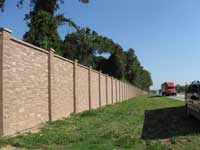
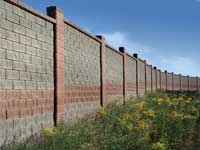
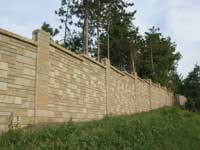
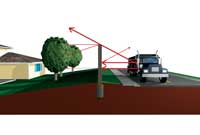
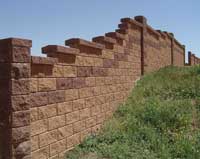
FHWA Guidelines:
The FHWA has also prepared the Highway Traffic Noise Analysis and Abatement Guidelines. The guidelines placed great emphasis on aesthetics including special mention to adding texture and appropriate colors for sound barriers and the cost effectiveness of the highway noise abatement measures.
Building Concrete Fence Sound Barrier
In 2002, the City of Calgary's bylaws mandated noise attenuation as part of it's structured planning process. Sound walls are the most common solution and were chosen for the new residential housing development in S.W. Calgary called Garrison Woods. Garrison Woods is a residential housing development and is adjacent to a six lane arterial roadway with a posted speed of 50 mph (80 kph). The developer wanted to ensure that the walls were aesthetically pleasing and complementary to their project, the city had to ensure both performance and budgets were met.
This was the first time an Allan Block Fence had ever been presented for a city project and although the City officials liked the look of AB Fence, steps were required to prove that it could meet the Cities technical requirements. Not only did the AB Fence solution exceed performance requirements, it cost less than the post & plank system and AB Fence was preferred by the developer for its attractiveness.
Phase One of the project called for a 1,230-ft (375 m) long fence wall separating the Crowchild Trail roadway and the subdivision. CWA Structural Engineering designed the AB Fence with assistance from Allan Block's Engineering department. The design consisted of a 13 ft (4 m) high fence wall and 10 ft (3 m) post spacing, which was based on the local wind loads, exposure conditions and height of the fence wall.
The Allan Block Fence system was a clear winner on this project, satisfying performance, financial and aesthetic needs. The success of this project has led to the city of Calgary accepting Allan Block fence as a preferred noise wall solution for several subsequent projects totaling over 500,000 ft² (46,450 m²).
The City personalized the fence project by sand blasting a Maple leaf in the posts. Great accent to an exceptional project.
Planning for a Successful Sound Barrier
The Federal Highway Administration (FHWA) has many resources about noise barriers and in one of their articles, Keeping the Noise Down, they provided some general information about highway noise barriers. Two things that they identified for noise barrier properties are basic fence geometry (height and length) as well as the material type used in its construction.
Fence Height:
At a minimum, a noise barrier must be tall and long enough to block the view of the highway, the “source”, from the area that is to be protected or what is referred to as the “receiver”. Therefore, there is very little protection for houses that are built on a hillside or that are taller than the barrier itself. Generally, a noise barrier can achieve a 5-decibel (dB) noise level reduction when the line-of-sight is broken from the highway to the receiver. A rule of thumb that is mentioned in the FHWA article is that after the line-of-sight is broken the barrier may reduce the noise level by an additional 1.5 dB for each 3.2 ft (1 m) of barrier height.
For the Garrison Woods project, Patching and Associates Acoustical Engineers were retained to provide a Field Performance Study. The fence wall heights were defined using bylaw design guidelines and this resulted in a 13-ft (4m) wall height to achieve the minimum five decibel noise reduction. For more information and a summary of the sound study click here.
Fence Length:
The length of the barrier is also important. To effectively reduce the noise coming around the ends of the barrier, it should be at least eight times as long as the distance from the receiver to the barrier. Any openings in the noise barrier can definitely impact their effectiveness.
Barrier Type:
Noise barriers have been constructed out of all types of materials from earth, concrete, masonry, wood, metal, etc. The key for any barrier is to reduce the amount of sound that is transmitted through the barrier. Therefore, the density of the material is important and why concrete block fence is so effective.
Sound Testing:
According to the FHWA an effective noise barrier will typically reduce noise levels by 5 to 10 decibels (dB), which in essence is cutting the traffic noise by as much as half. In our profiled project, the City of Calgary required a 5-dB reduction. After the project was completed Patching and Associates Acoustical Engineers determined what the actual noise reduction value was for the Garrison Woods fence. The AB Fence achieved a 13-dB noise reduction, which far exceeded the required 5-dB reduction. The combination of well designed wall geometry and quality material selection led to the project’s success.
It should be pointed out that noise barriers will not completely block all traffic noise, but using the right material will help. As previously discussed, the density of the material will directly influence the sound that is transmitted through the barrier itself. In 2002, Stork Twin Cities Testing was retained to determine the Sound Transmission Class (STC) and the absorption properties or noise reduction coefficient (NRC) for the AB Fence Panel in the acoustical testing chambers.
More information can be found on AB Fence Tech Sheet #2003. The results of these tests allow for comparison of the Allan Block manufactured system to products used in the noise barrier market. The results indicated an STC value of 32 and a NRC value of 0.1, which are standard for a masonry wall.
Material Life Cycle Cost:
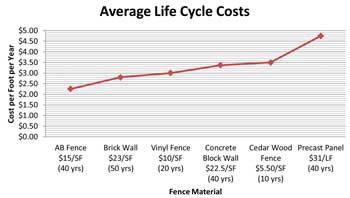
Every product has an initial investment of the material and installation, but what cannot be overlooked is how long will the product perform. By comparing the different options for sound walls and considering the average installation costs, expected life cycle of the product with any future maintenance costs, the AB Fence provides the best value as indicated in chart at right.
Design Flexibility:
The AB Fence can incorporate curves and corners with ease and use different colored/textured or multiple shaped blocks to create beautiful pattern fences. The system can accommodate dramatic grade changes and can be engineered for retaining soil applications.



